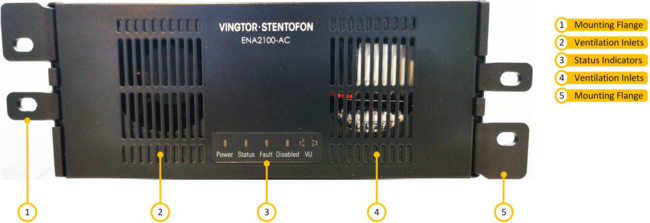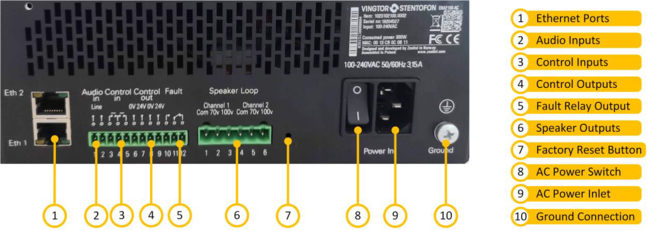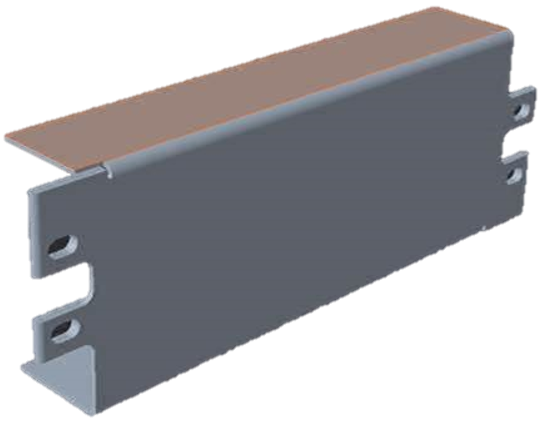Difference between revisions of "ENA2100-AC Amplifier - Mounting and Installation"
From Zenitel Wiki
(→Mounting) |
|||
| Line 49: | Line 49: | ||
* Kit for mounting a single ENA2100-AC amplifier in a 19-inch rack. | * Kit for mounting a single ENA2100-AC amplifier in a 19-inch rack. | ||
**ENA2100-AC single mounting, item Number: 1023532100 | **ENA2100-AC single mounting, item Number: 1023532100 | ||
| − | [[File: | + | [[File:Singlemount.png|left|650px|Single Amplifier kit]] |
<br style="clear:both;" /> | <br style="clear:both;" /> | ||
* Kit for mounting two ENA2100-AC amplifiers together in a 19-inch rack. | * Kit for mounting two ENA2100-AC amplifiers together in a 19-inch rack. | ||
** ENA2100-AC double mounting, item Number: 1023532110 | ** ENA2100-AC double mounting, item Number: 1023532110 | ||
| − | [[File: | + | [[File:Doublemount.png|left|650px|Double Amplifier kit]] |
<br style="clear:both;" /> | <br style="clear:both;" /> | ||
Revision as of 17:11, 3 January 2019
This article describes the mounting and installation of the ENA2100-AC amplifier.
Contents
Installation
Overview - Front
| 1 | Mounting Flanges | The mounting flanges are used to mount the unit in 19” equipment racks with 2HU in double configuration. |
| 2 | Ventilation Inlets | The ventilation inlets should be kept free of obstacles and dust. Fans control the airflow based on internal temperature. |
| 3 | Status Indicators | The status indicators are used to display the status of important parameters like power supply and faults. There is also a VU indicator for channel 1 and channel 2. |
Overview - Back
| 1 | Ethernet Ports | Redundant Ethernet connections for audio and control data. |
| 2 | Audio Input | Line-in audio input for external audio sources. |
| 3 | Control Inputs | 2 configurable control inputs. Each input is activated by closing the loop between the two terminals. |
| 4 | Control Outputs | 2 configurable control outputs. Each is made of a 24VDC signal. The 24VDC can source max 200mA and has overcurrent protection. |
| 5 | Fault Relay Output | A switching relay (NO, NC & COM) kept in the active position between COM and NO as long as no faults are present in the device. |
| 6 | Speaker Outputs | 100 and 70 volts outputs per channel. |
| 7 | Factory Reset Button | To reset the amplifier to factory default settings: Insert a straightened paper clip or similar device into the hole to press the reset button and hold for 7 to 8 seconds while powering up the amplifier. |
| 8 | AC Power Switch | Power switch for AC power. |
| 9 | AC Power Inlet | AC power inlet for 110 to 230 VAC. The power inlet has a V-Lock mechanism for a secure connection. |
| 10 | Ground Connection | Ground connection for grounding of the unit. This is connected in parallel with the ground connection in the AC power inlet. |
Placement and Stacking
The amplifier is designed to deliver full power at ambient temperatures up to 55 °C. As long as the equipment rack is well ventilated, amplifiers can be stacked with no extra space between them. It is however recommended to add 1 HU between every group of 4 amplifiers.
Mounting
There are two kits available for mounting of the amplifier:
- Kit for mounting a single ENA2100-AC amplifier in a 19-inch rack.
- ENA2100-AC single mounting, item Number: 1023532100
- Kit for mounting two ENA2100-AC amplifiers together in a 19-inch rack.
- ENA2100-AC double mounting, item Number: 1023532110
Power Supply
The Amplifier is connected to the equipment rack’s mains power.

|
The power input is equipped with a lock, preventing the plug from falling out. Make sure that the plug is properly inserted, and that the lock is engaged |
Grounding
It is always good practice to ground the cabinet of equipment installed in racks. This ensures safety and good EMC. If the unit is powered entirely through the DC power inlet, the ground connection is the only way to connect the Amplifier to ground. The ground connection of the Amplifier should be connected to the equipment rack’s ground strip using a ground wire of at least 0.75 mm² (AWG 19).

|
If the Amplifier isn’t connected to ground, it will not be able to detect ground faults or short-circuits to ground |
Ethernet Connections
The Amplifier is connected to the network using one of the two Ethernet ports.
Fault Relay
The Amplifier’s fault relay will trigger whenever a fault occurs in the amplifier. This relay is actively kept closed by the Amplifier so it will trigger even if the entire amplifier loses power. The connection to external equipment should be made according to the external equipment’s requirements. When no faults are present in the amplifier, an electrical connection is established between the COM and NO terminals of the fault relay. When a fault is detected, or the amplifier loses power, this connection is removed and a connection between COM and NC is established.
Control Inputs
There are 2 inputs available. The inputs can be used in a convensional way, or they can be monitorted.
- Conventional inputs have two states:
- Contact is Open
- Contact is Closed
Monitoring is done by connecting two resistors as close as possible to the external switch/relay, one in series and one in parallel. The resistor connected in series with the external switch/relay shall have a value of 1 kΩ, while the resistor connected in parallel shall be 2.2 kΩ.
- Monitored Inputs have four states:
- Contact is Open
- Contact is Closed
- Short circuit (error)
- Open circuit (error)
Monitoring of inputs must be enabled in the web interface: Amplifier Settings > RCO/RCI Config > RCIs section.
Control Outputs
There are 2 24V DC outputs.
- Rating: 24 VDC, ±10%, 200 mA
Audio Inputs
There is one audio input on the Amplifier which can be used for background music, external alarms or local microphone.
Loudspeaker Connections
The Amplifier has two different options for loudspeaker connections: 70 volts or 100 volts.



